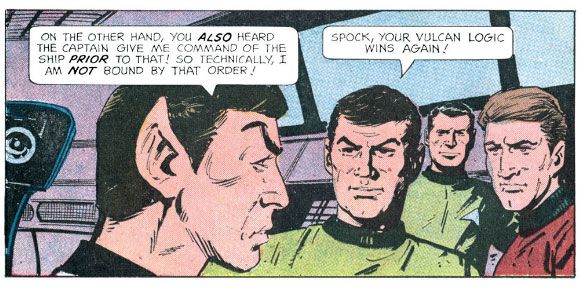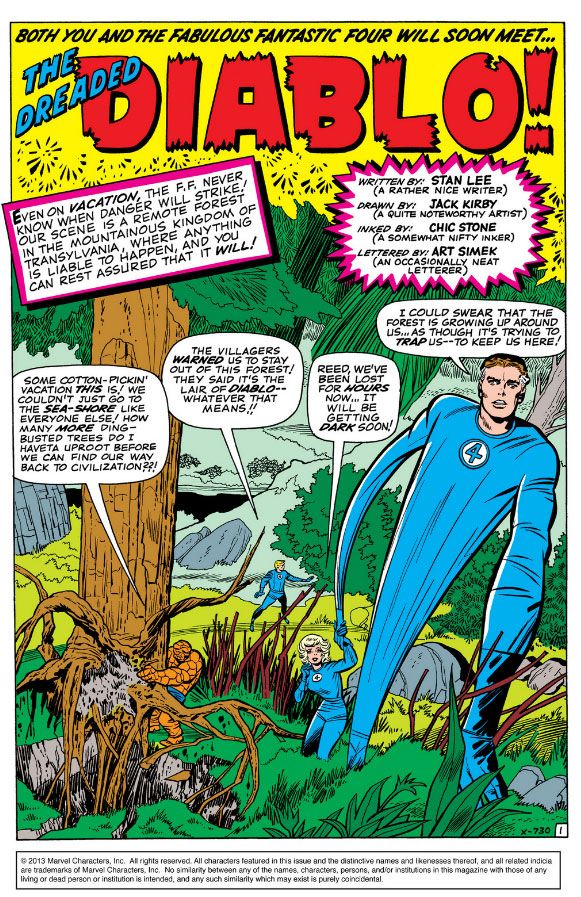Gold Key's
Star Trek #2 came out the same month I was born. We've grown up together. We're both awesome.
Star Trek #2 edges me by just a hair in the awesome department. And that hair is comic book Scotty's mousy brown versus James Doohan Scotty's glossy black.
Scripter Dick Wood takes the Enterprise and its crew to a mysterious glowing asteroid, but the story's title gives everything away-- "The Devil's Isle of Space." While Targu, the leader of the asteroid's castaway population insists they're simply victims of an unfortunate accident, Captain Kirk soon learns they're actually a prison population. Their culture has a novel approach to incarceration. Prisoners go to various asteroids to await execution at some unspecified future time. They're not even to know how they're to die. Spock adds the rather alarming extra bit of information that the asteroid is going to turn into a "super nova." I thought only stars did that, but Spock is a United Federation of Planets scientist, science officer of Starfleet's finest exploratory vessel and all-around genius so I'm going to bow to his superior space knowledge. Firing squad, gas chamber, electric chair, injection, exploding asteroid. Don't do the crime if you can't do the time, or so Sammy Davis, Jr. once advised us.
Spock certainly keeps his eye on the sparrow. He goes right to work doing what he does best-- solving problems. But this is a doozy, with moral implications. Spock's boss Kirk has a bit of a personal objection to the execution methodology and he's got even more of one when said methodology includes his own execution and those of his crewmembers, for whom he feels at least partly responsible. The obvious solution is to get the hell out of Dodge.

There are two complications. The first, an energy field trapping the Enterprise in orbit around the asteroid, lasts only as long as it takes Spock to apply his vast intellect to solving its problem. He invents "counter energy" to "flood the area," and that does the trick. The second isn't so easily done away with. Since the Enterprise transporters-- called the "teleportation chamber" here-- seem to lack the discriminatory circuits of the TV show's version, the landing party can't beam up... er... teleport back to the ship without bringing along a random selection of Targu's hardened criminals.

Fortunately for the landing party Spock isn't merely a top-notch astronomer; he's also a master of strategy. He has pseudo-Scotty and company build a flying replica of one of the prison rockets and fools the inmates into believing they're receiving a missile's worth of fresh fish. Surprise! It's pseudo-Scotty and his merry band of rescuers with "fire bombs," apparently some sort of relatively harmless flash-bang devices they use to chase away the convicts.
Within minutes, the Enterprise rockets to safety and all's well except for the criminals who die when the asteroid explodes.
Let's take a look at some of artist Nevio Zaccara's embellishments to th
e Star Trek universe. First, there are the knives he puts on the landing party's belts. Well, you never know. Some away missions may require whittling or making scrimshaw.
Also, he has Kirk mistake his tricorder for his communicator. Well, not just Kirk, but everyone, including the narration. Incredibly, it's a very screen-accurate tricorder as well, which makes it even more glaring to a hardened Trekker like myself, especially contrasted with Zaccara's free-wheeling version of the Enterprise interior and the crew's weapons, finally referred to in the comic as phasers.
Zaccara has a unique take on rendering likenesses among the secondary characters, i.e., anyone not named Kirk, Spock or McCoy: don't even attempt them. Here's a typical scene:
Spock appears Nimoyish but with that makeup an artist could hold the pencil with a couple of toes and stand a chance of drawing a passable caricature. Next to him is McCoy, in a green shirt. The eyebrows are sort of reminiscent of Deforest Kelley's. That guy in the red shirt, however, is the Scotty I've been telling you about. And between them, looking on from the back is Uhura. Other than drawing her hair a little shorter than it appears on the show, Zaccara has done a bang-up job on Uhura. Come to think of it, while Zaccara caricatured him accurately in the first issue, in this one Kirk often looks a lot like Sean Connery rather than William Shatner. Interesting bit of casting that would have been, huh? If not for that spy movie series...
Speaking of Uhura, the character actually has a non-speaking cameo earlier in the story and Zaccara produces a reasonable facsimile of Nichelle Nichols, but the colorist botches it in a way that's more obvious and egregious than Scotty's hair or anyone's service tunic. And I'm not talking about the bright yellow dress she sports for some reason known but to our anonymous colorist.
Zaccara can draw this stuff any old way he pleases as far as I'm concerned. Yeah, it's fun to pick at it but at least Zaccara produced vigorous stuff. Because he seemingly wasn't tied to producing perfect images for licensing purposes-- make the bridge look like the TV show because we've got a playset coming out and we need the extra advertisement, please-- he just invents using his own unique visual flair and we get something kind of weird, kind of funky, definitely fun. It's not his fault my brain has been trained over the years into an encyclopedia of useless crapola, but with startling gaps. What Zaccara's art lacks in
Trek accuracy it makes up for with energy and a kind of EC-ish feel. That's a more than fair trade-off, plus it gives me something to write about 45 years later.
On that note, one final observation. In what had quickly become a Gold Key
Star Trek tradition, the plot ends rather abruptly and violently.
"The Devil's Isle of space-- nothing but a floating cloud of dust now! It seems brutal to have left those people there..." Kirk says in the last panel.
"Execution by asteroid explosion is the way of their society! We had no other choice but to leave them, Captain!" Spock concludes. In other words, "To hell with them."
NOTE-- I'm off for a couple of weeks, so no updates until later this month. I'm sure you're breathing a sigh of relief there!























